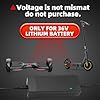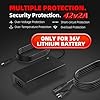Brokeir UL Listed 42V 2A Replacement Electric Scooter Charger for 36V Hoverboard Charger with 5 Plugs, Compatible with Scooter Power Adapter
31% OffMost hoverboards support between 44-220 lbs, but this varies significantly by wheel size and brand. The Swagtron T6 Outlaw handles up to 420 lbs, while standard 6.5-inch models typically max out at 220 lbs. Exceeding your hoverboard’s weight limit reduces battery life, affects speed, and can damage internal components.
Understanding your hoverboard’s weight capacity is crucial for safety, performance, and longevity. This guide covers everything you need to know about hoverboard weight limits, helping you choose the right board and ride safely.
Quick Reference: Hoverboard Weight Limits by Wheel Size
| Wheel Size | Typical Weight Range | Best For | Max Speed |
|---|---|---|---|
| 4.5 inches | 44-120 lbs | Kids (5-10 years) | 6 mph |
| 6.5 inches | 44-220 lbs | Teens & Light Adults | 7.5 mph |
| 8 inches | 44-265 lbs | Adults | 10 mph |
| 10+ inches | 44-420 lbs | Heavy Adults | 12+ mph |
What Is a Hoverboard Weight Limit?

A hoverboard weight limit refers to the maximum weight the device can safely support while maintaining optimal performance. This includes:
- Your body weight
- Clothing and gear (helmet, backpack, winter clothes)
- Any carried items
The weight limit is determined by several factors:
- Motor power and torque capacity
- Battery performance under load
- Structural integrity of the frame
- Wheel size and tire specifications
- Gyroscope and sensor sensitivity
Why Hoverboard Weight Limits Matter
Safety Concerns
Exceeding weight limits creates serious safety risks:
- Reduced stability – Harder to balance and control
- Sudden stops – Board may shut down unexpectedly
- Structural failure – Frame or components may break
- Increased fall risk – Especially dangerous for heavier riders
Performance Impact
Riding over the weight limit affects:
- Speed reduction – Motors struggle under excess load
- Battery drain – Up to 50% shorter ride time
- Heating issues – Components overheat faster
- Rough terrain problems – Can’t handle inclines or bumps
Long-term Damage
Consistent overloading causes:
- Motor burnout and premature failure
- Battery degradation and reduced capacity
- Sensor malfunction affecting balance
- Structural stress leading to cracks
Popular Hoverboard Weight Limits by Brand
Premium Models (High Capacity)
Swagtron T6 Outlaw

- Weight limit: 420 lbs
- Wheel size: 10 inches
- Best for: Heavy adults, all-terrain use
- Price range: $300-400
Epikgo Sport Plus

- Weight limit: 240 lbs
- Wheel size: 8.5 inches
- Best for: Adults, outdoor adventures
- Price range: $350-450
Standard Models (Medium Capacity)
Razor Hovertrax 2.0

- Weight limit: 220 lbs
- Wheel size: 6.5 inches
- Best for: Teens and average adults
- Price range: $150-200

- Weight limit: 220 lbs
- Wheel size: 10.5 inches
- Best for: Commuting adults
- Price range: $400-500
Kids Models (Low Capacity)
Jetson Flash

- Weight limit: 132 lbs
- Wheel size: 6 inches
- Best for: Kids and young teens
- Price range: $100-150
Hover-1 Chrome

- Weight limit: 160 lbs
- Wheel size: 6.5 inches
- Best for: Teens
- Price range: $120-180
How to Find Your Hoverboard’s Weight Limit
Check the Manual
The most reliable source is your hoverboard’s documentation:
- Look for “Maximum Load” or “Weight Capacity”
- Check both minimum and maximum weights
- Note any specific riding conditions
Manufacturer Specifications
Visit the manufacturer’s official website:
- Search by model number
- Download the complete specification sheet
- Contact customer support for clarification
Physical Inspection
Look for stickers or labels on the board itself:
- Usually located on the bottom
- May include weight limits and safety warnings
- Check both the board and charging port area
Minimum Weight Requirements
Most hoverboards require a minimum weight of 44 lbs to function properly. Here’s why:
Sensor Activation
Hoverboards use pressure sensors to detect riders:
- Too light = sensors may not activate
- Board won’t respond to balance adjustments
- Risk of unexpected movements
Balance Issues
Lighter riders may experience:
- Difficulty controlling direction
- Unstable starts and stops
- Higher learning curve
Solutions for Light Riders
If you’re under the minimum weight:
- Add weighted vest or backpack
- Choose boards with lower minimum requirements
- Practice in safe, controlled environments
- Consider waiting until you reach minimum weight
What Happens When You Exceed Weight Limits

Immediate Effects
Performance Issues:
- Slower acceleration and top speed
- Difficulty climbing inclines
- Reduced maneuverability
- Vibration and instability
Safety Concerns:
- Board may beep continuously
- Sudden shutdowns during rides
- Increased risk of falls
- Harder to dismount safely
Long-term Consequences
Component Damage:
- Motor strain and overheating
- Battery cell degradation
- Gyroscope sensor malfunction
- Structural frame stress
Financial Impact:
- Voided warranty coverage
- Expensive repair costs
- Shortened device lifespan
- Need for earlier replacement
Choosing the Right Hoverboard for Your Weight
For Kids (44-100 lbs)
Recommended Features:
- 4.5 to 6.5-inch wheels
- Speed limiting features
- Beginner-friendly controls
- Bright LED lights for visibility
Top Picks:
- Jetson Flash (132 lb limit)
- Hover-1 Chrome (160 lb limit)
For Teens (100-160 lbs)
Recommended Features:
- 6.5 to 8-inch wheels
- Bluetooth speakers
- App connectivity
- Good battery life (6+ miles)
Top Picks:
- Razor Hovertrax 2.0 (220 lb limit)
- Swagtron T580 (220 lb limit)
For Adults (160-220 lbs)
Recommended Features:
- 8-inch wheels minimum
- All-terrain capabilities
- Extended battery life
- Durable construction
Top Picks:
- Epikgo Sport (240 lb limit)
- Gyroor Warrior (265 lb limit)
For Heavy Adults (220+ lbs)
Recommended Features:
- 10+ inch wheels
- Maximum weight capacity
- Reinforced frame
- Powerful dual motors
Top Picks:
- Swagtron T6 Outlaw (420 lb limit)
- Halo Rover X (264 lb limit)
Weight Distribution and Balance Tips

Proper Stance
For optimal performance regardless of weight:
- Keep feet shoulder-width apart
- Distribute weight evenly
- Maintain upright posture
- Avoid leaning too far forward/back
Mounting and Dismounting
Safe Mounting:
- Step onto board one foot at a time
- Use a wall or support for balance
- Wait for board to stabilize
- Gradually shift weight to activate
Safe Dismounting:
- Come to complete stop
- Step backward off the board
- Don’t jump forward off the front
- Keep board steady with one foot
Maintenance Tips for Different Weight Users
Heavy Riders (Near Weight Limit)
Extra Care Needed:
- Check tire pressure more frequently
- Monitor battery health closely
- Inspect frame for stress signs
- Allow cooling time between rides
Recommended Schedule:
- Weekly visual inspections
- Monthly detailed cleaning
- Quarterly professional check-ups
Light Riders (At Minimum Weight)
Focus Areas:
- Sensor calibration
- Balance system maintenance
- Software updates
- Proper storage
Safety Guidelines by Weight Category

Universal Safety Rules
Regardless of weight, always:
- Wear protective gear (helmet, pads)
- Start in open, flat areas
- Avoid wet or uneven surfaces
- Follow local laws and regulations
- Never exceed speed limits
Weight-Specific Precautions
Heavier Riders:
- Allow extra stopping distance
- Avoid steep inclines
- Take breaks to prevent overheating
- Consider upgraded models with higher limits
Lighter Riders:
- Practice balance extensively
- Start with lower speeds
- Use training mode if available
- Ensure proper sensor activation
Frequently Asked Questions
Can I exceed the weight limit for short rides?
No, even brief periods over the weight limit can damage components and create safety hazards. The weight limit applies to all usage.
Do backpacks and gear count toward the weight limit?
Yes, the weight limit includes everything you carry – clothing, backpacks, helmets, and any other items.
How accurate are manufacturer weight limits?
Manufacturer limits include safety margins, but they should be strictly followed. Some testing shows boards can handle slightly more, but this voids warranties and increases risks.
What if I’m right at the weight limit?
If you’re within 10-15 lbs of the limit, consider a model with higher capacity for better performance and longevity.
Can weight limits change over time?
The board’s capacity doesn’t change, but battery degradation and component wear may reduce effective performance under maximum load.
Do different terrains affect weight limits?
Yes, rough terrain, inclines, and soft surfaces effectively reduce the practical weight limit. Flat, smooth surfaces provide optimal performance.
Conclusion
Understanding hoverboard weight limits is essential for safe, enjoyable riding. Choose a board that comfortably accommodates your weight with room to spare, follow manufacturer guidelines, and prioritize safety over convenience.
Remember that weight limits exist for your protection and to ensure optimal performance. When in doubt, opt for a higher-capacity model – it’s a worthwhile investment for safety, performance, and longevity.
For the best experience, select a hoverboard that supports at least 20-30 lbs more than your total weight (including gear). This ensures reliable performance, longer battery life, and safer operation across various riding conditions.

I’m the founder of HoverboardsGuide.com, a comprehensive website dedicated to electric scooters and hoverboards. With a deep-rooted passion for electric gadgets, I’ve accumulated extensive experience in this field. I aim to assist users in selecting the best gadgets and providing reliable guidance.
I’ve tested and reviewed numerous models, gaining in-depth knowledge about their features, performance, and overall quality. Feel free to reach out to me with any queries, as I’m dedicated to addressing your concerns promptly. Join me on this exciting journey of exploring the world of electric rides and making informed decisions













